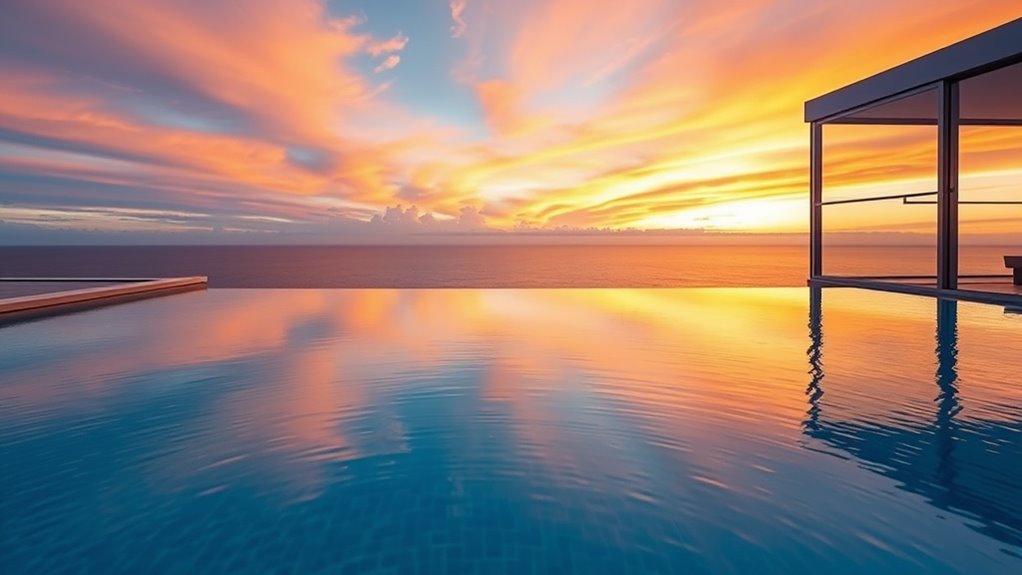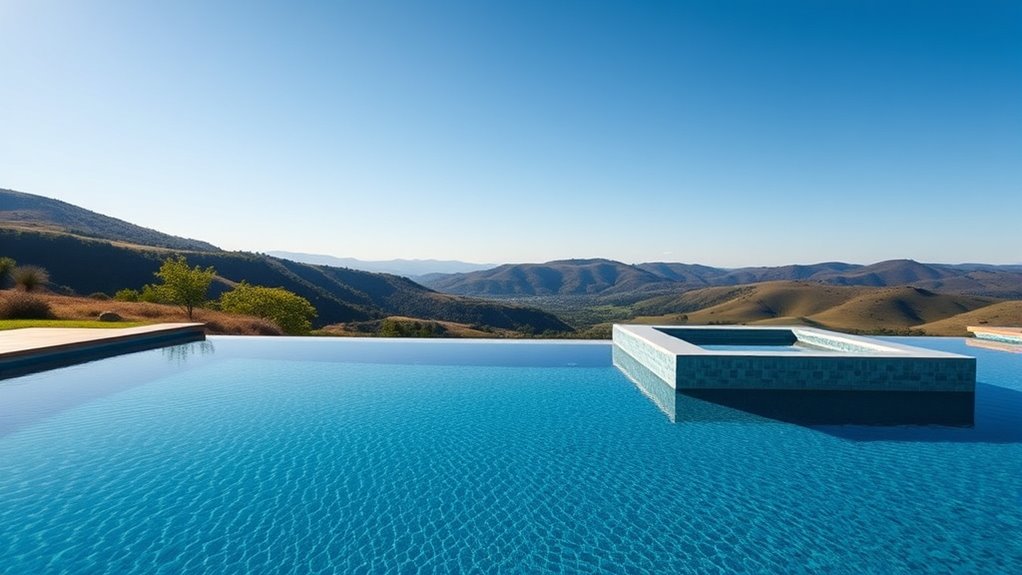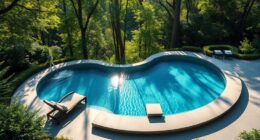Choosing between two-sided and three-sided infinity edges depends on your style and budget. Two-sided edges offer a sleek, minimalist look that blends well with modern designs, and they are typically more affordable and easier to maintain. Three-sided edges create a striking, seamless waterfall effect and can make your pool more immersive, but they tend to cost more and require extra space. To discover which option best suits your needs, explore more insights below.
Key Takeaways
- Two-sided edges offer a sleek, minimalist look, while three-sided edges create a dramatic, seamless waterfall illusion.
- Three-sided edges are more costly and require more space and maintenance than two-sided options.
- The choice depends on desired visual impact: subtle elegance versus bold, immersive effects.
- Two-sided edges suit modern, understated designs; three-sided edges enhance striking focal points.
- Regional climate and landscape influence installation, durability, and long-term maintenance considerations.
Visual Impact and Aesthetic Appeal

When choosing between two-sided and three-sided infinity edges, the visual impact and aesthetic appeal can substantially influence your overall design. A two-sided edge creates a sleek, minimalist look, emphasizing clean lines and simplicity. It’s perfect if you prefer a modern, understated style that blends seamlessly with your surroundings. On the other hand, a three-sided infinity edge offers a more dramatic, seamless appearance, giving the illusion of an endless waterfall from multiple angles. This design enhances the overall elegance and can serve as a striking focal point. Your choice depends on the effect you want to achieve: minimal and refined, or bold and immersive. Both options can elevate your space, but your personal aesthetic preferences will ultimately guide the best decision. Additionally, understanding visual harmony can help you select the most suitable design to complement your environment.
Practical Considerations and Cost Factors

Practical considerations and cost factors play a crucial role in determining whether you should choose a two-sided or three-sided infinity edge. Budget is often the first concern; three-sided edges typically cost more due to increased materials and labor. Maintenance also influences your choice; three-sided edges may require more upkeep because of additional seams and joints. Space availability matters, as three-sided edges need more room for proper installation and support. You’ll want to think about your pool’s shape and your aesthetic goals—if you prefer a seamless look from multiple angles, investing in a three-sided edge might be worthwhile. However, if your budget is limited or space is tight, a two-sided edge can still deliver a stunning infinity effect with lower costs and easier installation. Additionally, understanding the region-specific features can help you choose the most suitable design for your environment.
Frequently Asked Questions
How Does Edge Design Affect Pool Safety?
Edge design critically impacts pool safety by influencing slip risk and barrier effectiveness. With a three-sided infinity edge, you create a seamless visual appeal but must guarantee proper drainage and anti-slip surfaces to prevent accidents. Two-sided edges often offer more stability and easier access, reducing fall hazards. You should prioritize slip-resistant materials, clear signage, and proper barriers regardless of the design to keep swimmers safe while enjoying the pool.
Can Infinity Edges Be Customized for Unique Pool Shapes?
Yes, infinity edges can be customized for unique pool shapes. Imagine a seamless, flowing waterline that perfectly follows your landscape or architectural design, creating a stunning visual effect. Skilled designers and installers can tailor the edge to match curves, angles, or unconventional layouts, giving you a truly personalized pool. This customization enhances aesthetic appeal and maximizes the infinity illusion, making your pool a one-of-a-kind masterpiece tailored to your vision.
What Maintenance Challenges Are Specific to Each Edge Type?
You’ll find that two-sided infinity edges require regular cleaning of the exposed glass or acrylic panels to prevent buildup and guarantee clarity. Three-sided edges can be more challenging because they often have larger, more complex seals that need inspection for leaks or damage. Both types demand routine maintenance of the structural components, but three-sided edges may also need extra attention to the surrounding framing and sealing to prevent water leaks.
Are Two-Sided Edges More Energy-Efficient Than Three-Sided?
You’ll find that two-sided edges are generally more energy-efficient than three-sided ones, like a sleek sports car compared to a bulky truck. This efficiency comes from less material and fewer joints, which reduces heat loss and energy consumption. With fewer edges exposed, you’ll notice better insulation and lower energy bills. So, if saving energy is your goal, two-sided edges give you an elegant, cost-effective option that’s hard to beat.
How Do Local Regulations Impact Infinity Edge Installations?
Local regulations considerably influence your infinity edge installation, as they set safety standards, height restrictions, and permits you need. You should check with your local authorities before starting, since some areas may have strict rules against certain designs or require special safety features. By complying, you ensure a smooth installation process, avoid fines, and guarantee your pool meets all safety and legal requirements, giving you peace of mind and a beautiful, compliant infinity edge.
Conclusion
Choosing between two-sided and three-sided infinity edges is like picking the perfect frame for a masterpiece. Two-sided edges offer sleek simplicity, while three-sided ones add depth and drama. Think of it as shaping a sculpture—you decide whether you want clean lines or more dimension. Ultimately, your choice shapes the visual story you tell. So, weigh your style and practical needs carefully; your infinity edge is the frame that completes your space’s masterpiece.










